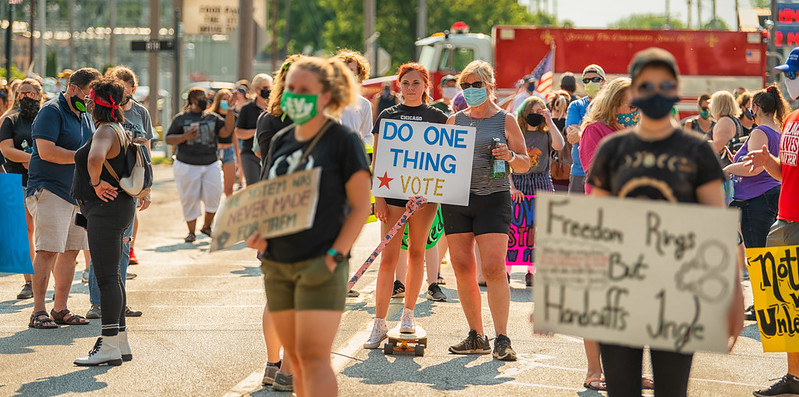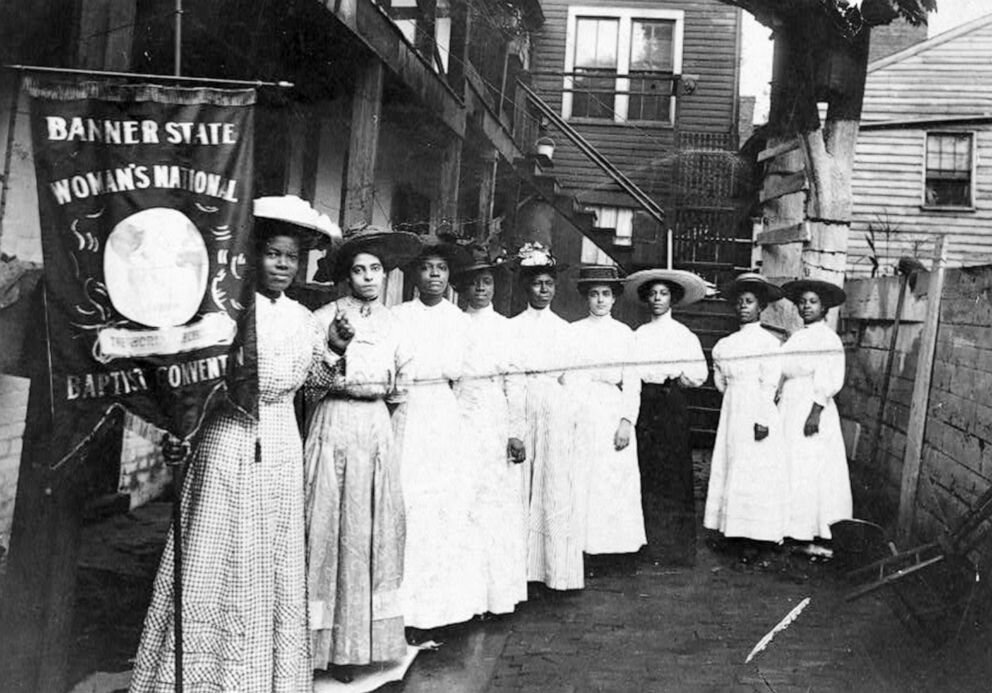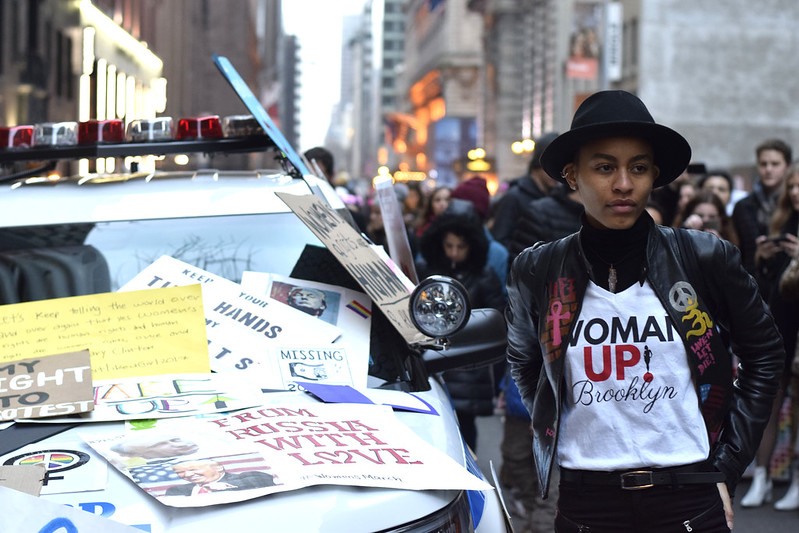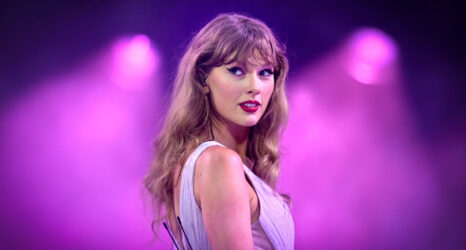
Pictured: A Juneteenth demonstration in Chesterton, Ind. (Roman K / Flickr)
August 26, 2020 was a Women’s Equality Day like no other. And, this year, underlying the largest gender gaps in history, is the growing proportion of women who identify as feminists—a situation the suffragists hoped would happen after women fought and won the vote.
Little did they know, a hundred years later, women would be voting in higher proportions and higher numbers than men. And trends so far indicate men are shifting toward women on key issues—such as gender equality, racial justice, the coronavirus pandemic, health care and the economy.

1920 was a moment in history, as the then-approaching presidential election would be the first time when women could legally vote in all 50 states.
After a full century of struggle to win suffrage, women’s turnout in that election was modest at best, due to barriers our mothers and grandmothers faced around race, class and culture: Only 36 percent of women voted in the 1920 presidential election—compared to 68 percent of men.
And, not until Jim Crow laws were voided by the 1964 Civil Rights Act and the 1965 Voting Rights Act did turnout rates start to climb among Black voters and other people of color.
Finally, 60 years after ratification of the suffrage Amendment, turnout rates reached the same for women and men. Since 1980, the proportion of eligible female adults who voted has exceeded the proportion of eligible male adults who voted.
100 Years Since Suffrage, a Growing Number of Feminist Voters
The feminist factor—the proportion of voters who self-identify as feminists—is stronger than at any time in the past and is driving the gender gap to become a gulf, and some analysts say, a canyon, recently validated by a Pew Research Center report revealed the growing number of women who identify as feminists.
Released this summer, the Pew Research Center asked, “How, if at all, does the word feminist describe you?” Sixty-one percent of all women polled said “very well” or “somewhat well,” (19 percent and 42 percent respectively).

Identifying as a feminist cuts across all racial and ethnic lines, with 64 percent of Black women, 63 percent of Hispanic women and 59 percent of white women responding “very” or “somewhat well.”
In addition to responses from women of color, the highest responses were among young women (68 percent), Democrats (75 percent) and those with a college degree (72 percent). Even among men, Pew found four-in-ten say feminist describes them.
Ms. has been commissioning polls tracking feminism for over a decade. Between 2000 and 2010, on average 50 percent of all women identified as a feminist when asked: Do you consider yourself to be a strong feminist, a feminist, not a feminist, anti-feminist? Over those 15 years, less than 5 percent said anti-feminist, while about a third said “not a feminist.”
Then, in the 2008 presidential elections, Ms. tracked feminist voters by commissioning election day polls with Lake Research Partners—and found 40 percent of the electorate considered themselves feminist. Of these, 64 percent were women and 36 percent were men.
In 2010 elections, again 40 percent of all voters identified as feminists. About half (48 percent) of all female voters and 32 percent of male voters.
Compare the 40 percent feminist voter in 2010 to:
- 36 percent of voters who identified as born-again Christian/Evangelicals,
- 29 percent who said they were impacted by the Tea Party, and
- 38 percent who were supporters of the National Rifle Association.
By 2012, 43 percent of all voters considered themselves feminists, with:
- more Democratic women (72 percent feminist),
- Latinas (71 percent feminist),
- African American women (66 percent feminist),
- all Democrats (59 percent feminist), and
- younger women (58 pecent feminist).
The 2016 election voter polls showed 59 percent of women voters considered themselves feminist—up slightly from 57 percent in the 2012 presidential election (when a feminist factor was first explored more fully by Ms.).
The Current State of the Feminist Electorate
The 2020 Pew Research report of 3,143 adults over 18 years old is the most recent analysis to explore feminism, the feminist movement, the ERA and other trends including views on equality and culture change. In addition to the 61 percent of women who say the word “feminist” describes them, here are a few other key findings:
- Both women and men say the feminist movement has contributed to the advancement of women’s rights, with 22 percent saying the movement has done a great deal and 48 percent saying it has done a fair amount.
- Women are more likely than men to associate feminism with positive attributes, like empowering and inclusive, while men are more likely than women to see feminism as polarizing and outdated. Even so, six in ten men say feminism is empowering.
- On gender equality, a majority (57 percent) of adults say the United States has not gone far enough when it comes to giving women equal rights with men.
- Among those who think the country still has work to do in achieving gender equality, 77 percent say sexual harassment is a major obstacle to women’s equality. Strong majorities also point to other obstacles: 67 percent say women don’t have the same legal rights; 66 percent say that there are different expectations for men and women; and, 64 percent say there are not enough women in positions of power. Women are more likely to say these are major obstacles by ten or more points than men.
- Americans are more than twice as likely to say that, when it comes to gender discrimination, the bigger problem is people not seeing it where it really does exist—rather than people seeing discrimination where it does not exist (67 percent vs. 31 percent).
- Most who say the country still has work to do on gender equality, say equality is likely to be achieved in the future.
- On the Equal Rights Amendment, strong majorities of both women (82 percent) and men (73 percent) support adding the ERA to the U.S. Constitution. This majority support includes 66 percent of Republicans, with 75 percent of Republican women, supporting ERA.
Although across political parties and gender-lines, majorities say the U.S. has made progress in women’s equality over the last ten years and gender equality is very likely in the future, 64 percent say not enough women in positions of power is a major obstacle to achieving equality. This election could test voters’ willingness to ease this obstacle.
The Gender Gap is Now a “Canyon”
The measurable difference between the voting behavior and political attitudes of women and men—called the gender gap—first came into public awareness in the 1980s, due in large part to the work of feminist groups that hoped state legislators of both parties would see their self-interest and support the Equal Rights Amendment.
Democrats seemed to understand this, with a majority voting yes. But by 1982, some 83 percent of Republicans legislators in key unratified states had voted against the ERA.
Today this trend continues, with the Democratically controlled House of Representatives voting to allow states to continue the ERA ratification process while the Republican Senate has yet to consider the legislation. Republicans clearly do not comprehend the lasting impact that voting against constitutional equality and for policies opposite of the views held by a majority of women would have on their party.

At the time of the 2012 presidential elections, the gender gap became a gulf of double digits. Fifty-three percent of women voters supported Obama compared to 42 percent of men. And famously, Hillary Clinton received 2.9 million more votes than Donald Trump in 2016, even though the electoral college results gave an edge to Republicans.
In 2016, 54 percent of women voted for Clinton, compared to 41 percent of men—with 42 percent of women for Trump, compared to 53 percent of men.
Moving to the November elections, the simple math is as follows:
- In 2016, women cast 9.8 million more votes than men, according to the Center for American Women and Politics—with 63.3 percent of women casting 73.7 million votes, compared to 59.3 percent of men casting 63.9 million votes.
- Women are roughly 53 percent of eligible voters, compared to 47 percent of men.
- Thus, more women are eligible to vote and are voting in higher proportions than men.
If voting rates and turnout among women go beyond the last presidential election and are the highest ever reported—in 2008 as 65.5 percent—then the gender gap and feminist factor’s impact on the outcome of the 2020 elections will likely be even larger than in 2018 or past presidential elections.





